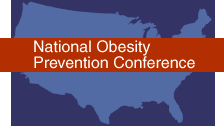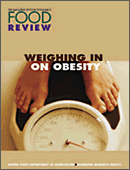|
overview
Americans enjoy one of the most bountiful and affordable food supplies
in the world. Yet, with this abundance comes overconsumption of total
fat, saturated fat, and cholesterol. Solutions begin with understanding
consumer behavior and the factors that influence food choices. ERS examines
all aspects of American food choices: what we eat, where we eat it, why
we eat it, what effect these choices have for America's farmers, and what
might be the health consequences of those choices. More
overview...
features
 National Obesity Prevention Conference—The U.S. Department of Agriculture will host a National Obesity Prevention
Conference on October 25-27, 2004 at the Hyatt Regency Hotel in Bethesda,
Maryland. The goal of the conference is to identify research and actions needed
to help prevent obesity by bringing together experts from government,
universities, the food industry, and numerous medical and nutrition research
facilities. This will be a science-based, multidisciplinary conference with a
practical orientation that acknowledges the social, economic, and behavioral
causes of poor dietary choices. The conference is open to the public and early
registration is encouraged. National Obesity Prevention Conference—The U.S. Department of Agriculture will host a National Obesity Prevention
Conference on October 25-27, 2004 at the Hyatt Regency Hotel in Bethesda,
Maryland. The goal of the conference is to identify research and actions needed
to help prevent obesity by bringing together experts from government,
universities, the food industry, and numerous medical and nutrition research
facilities. This will be a science-based, multidisciplinary conference with a
practical orientation that acknowledges the social, economic, and behavioral
causes of poor dietary choices. The conference is open to the public and early
registration is encouraged.
 Weighing
In on Obesity—This issue of FoodReview finds ERS researchers "weighing in" on a critical public health issue—the growing
epidemic of Americans who are overweight and obese. The lead article takes
a look at the American diet—typically too high in added sugars,
refined grains, fats, and calories. Other articles examine the relationship
between caloric intake and obesity, individuals' misperceptions about
their weight status, the link between fruit consumption and body weight,
and the cost-effectiveness issues raised by Federal interventions to reduce
obesity. Another article looks at the use of emergency food pantries by
U.S. households. Weighing
In on Obesity—This issue of FoodReview finds ERS researchers "weighing in" on a critical public health issue—the growing
epidemic of Americans who are overweight and obese. The lead article takes
a look at the American diet—typically too high in added sugars,
refined grains, fats, and calories. Other articles examine the relationship
between caloric intake and obesity, individuals' misperceptions about
their weight status, the link between fruit consumption and body weight,
and the cost-effectiveness issues raised by Federal interventions to reduce
obesity. Another article looks at the use of emergency food pantries by
U.S. households.
Patterns of
Caloric Intake and Body Mass Index Among U.S. Adults—Marked
differences in caloric intakes exist across income and education subgroups
over the whole range of intake levels, from light to moderate to high.
When these differences are compared with differences in body fatness (as
measured by Body Mass Index) across the same income and education groups,
the patterns tends to match for men but not for women. For example, a
greater share of low-income men consumes excessive calories and has BMIs
in the obese range than high-income men. Among women, however, low incomes
tend to be associated with high BMIs but lower caloric intakes. Determining
the causes of disagreements between patterns of caloric intake and body
fatness across sociodemographic groups may lead to a better understanding
of the causes of disparities in overweight and obesity.
Overweight Children:
Is Parental Nutrition Knowledge a Factor?—The growing number
of overweight children in the United States has sounded a public health
alarm. Overweight children are much more likely to end up obese when they
are adults and increase their risk of some chronic diseases. Parents with
greater knowledge about and interest in nutrition are less likely to have
overweight children. Parents' weight status and their own perception of
their weight status can also factor into the prevalence of overweight
children.
recommended readings
America's Eating Habits: Changes and Consequences—Chapters
in this book provide different perspectives on nutrition in the United
States.
U.S. Per Capita Food Supply Trends: More Calories, Refined Carbohydrates, and Fats—ERS's loss-adjusted annual per capita food supply series suggests that average daily calorie consumption in the United States in 2000 was 12 percent, or roughly 300 calories, above the 1985 level. Of that increase, grains (mainly refined grains) accounted for 46 percent, added fats 24 percent, added sugars 23 percent, fruits and vegetables 8 percent, and the meat and dairy groups together declined 1 percent. Per capita availability of total dietary fat, after remaining steady from 1985 to 1999, jumped 6 percent in 2000. American diets are also low in whole grains and other nutritious foods.
The Diets of America's Children: Influences
of Dining Out, Household Characteristics, and Nutrition Knowledge—Examines
the impact of food consumed at home and away from home on the diets of
America's children.
Factors Affecting Nutrient Intake of
the Elderly—The rapid expansion of the population age 60 and
older has a number of economic implications. The people in this group,
about 18 percent of the population, account for about 30 percent of all
health care expenditures. Providing information on the relationship of
socioeconomic and other factors to nutrient intake is basic to improving
the health and well-being of the elderly.
A Dietary Assessment of the U.S. Food
Supply: Comparing Per Capita Food Consumption with Food Guide Pyramid
Serving Recommendations—Estimates Food Guide Pyramid servings
for 250 agricultural commodities in the U.S. food supply. Uses new techniques
that adjust food supply data for food spoilage and other losses accumulated
through the marketing system and the home.
The Economics of Obesity: A Report on the Workshop Held at USDA's Economic Research Service—At a basic level, weight gain and obesity are the result of individual choices. Consequently, economics, as a discipline that studies how individuals use limited resources to attain alternative ends, can provide unique insight into the actions and forces that cause individuals to gain excessive weight. This report presents a summary of the papers and the discussions presented at the workshop.
See all recommended readings…
recommended data products
Data on food consumption and nutrient intake—These
tables describe consumption of different food groups and nutrient intakes
by age, gender, and eating locale.
Food Consumption (Per Capita) Data System—ERS annually calculates the amount of food available for human consumption in the United States. This series tracks historical national aggregate consumption of several hundred basic commodities. It is the only continuous source of data on food and nutrient availability in the United States and provides data back to 1909 for many commodities. See also the related report, Food Consumption, Prices, and Expenditures, 1970-97.
recent research developments
Is Your Diet Healthful?—According
to a recent ERS study, 40 percent of household meal planners/preparers
are dietary optimists—that is, they rate their diet quality to be
better than it actually is. The study uses USDA's Continuing Survey of
Food Intakes by Individuals (CSFII) and the Diet and Health Knowledge
Survey (DHKS) to look at Americans' perceptions of their dietary intakes
as compared with their actual intakes measured from 24-hour dietary recalls.
related briefing rooms
related links
The USDA Interactive Healthy Eating Index—Determine
the overall quality of your diet.
USDA Food Surveys Research Group—Provides tables based on the
the Continuing Survey of Food Intakes by Individuals (CSFII) in 1994-96
and 1998 and the Diet and Health Knowledge Survey (DHKS) in 1994-96.
See all related links…
for more information, contact:
Jay Variyam
web administration: webadmin@ers.usda.gov
page updated: August 23, 2004
|